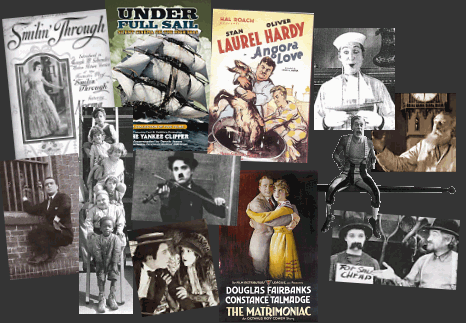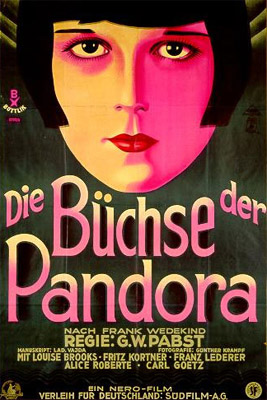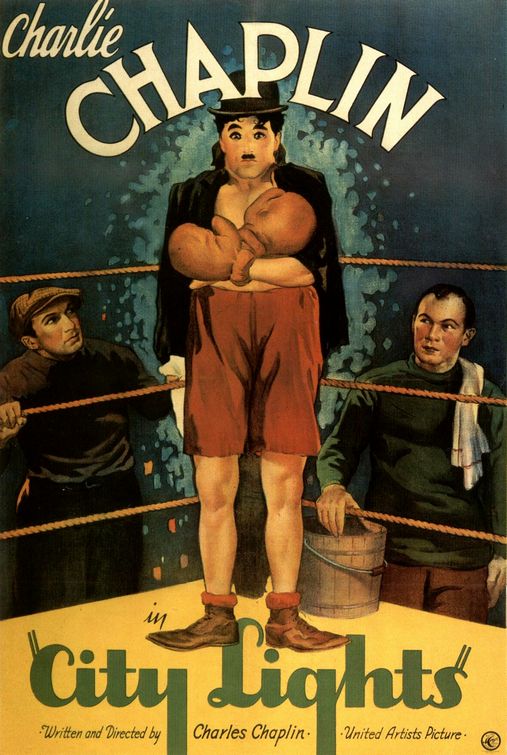Starting with Number One:
Pandora's Box is unquestionably my favorite film ever made. Nothing else even comes close. I have written before for CineThreatOnline about this 1929 masterwork from the great G.W. Pabst, and I stand by my sentiments entirely.
Pandora's Box is one of those mystifying and enigmatic pictures. A monumental artistic achievement, and the Silent Era's last gasp of life. Pandora's Box is a character study of everyone in the film with the exception of it's main character Lulu. As a spectator, you are not supposed to wonder why Lulu does the things she does, but you are supposed to be greatly affected by them. Just like the other characters in the film, you are both obsessed and repulsed by what Louise Brooks as Lulu makes you feel. She makes you feel woozy, confused, and lost. She makes you fall in love. And she makes you bleed because of it.
No one could create Louise Brooks, just like no one could create Pabst's 'Lulu'. No. Pabst's 'Lulu' had to be real, had to exist, and had to do so naturally; unaware. No. Louise Brooks is not a Pabst invention, and neither is her performance in Pandora's Box. What Pabst did, quite simply, was find his 'Lulu'. The film itself is pure invention, Pabst used psychology as his weapon and his intellect as his charm. He pinned actors against each other, he favored one actor on Monday only to dismiss him by Tuesday. Pabst created the purest form of realism possible. By exposing his actor's insecurities, hiding the plot from them, and initiating mind games with every member of the cast on and off set. Pabst loved chess. His love of chess is evident in Pandora's Box. Pandora's Box is his 'check-mate'.
So. No. Pabst did not create Lousie Brooks. Pabst made Lousie Brooks what she is today; an ultimately tragic relic of a bygone age. I cannot believe how astonishingly perfect Pandora's Box was conceived. Pabst is a true nobleman of the cinema for a number of reasons, my confidence will never sway in that regard. Pabst made the perfect film. A rarity, a pleasure, and a true art. His direction, the key to the enigma, only comes out of its perpetual hiding after a few viewings. It is Louise Brooks, and only Louise Brooks, that your eyes and heart feast on during the first time you watch Pandora's Box. Brooks was the most enchanting, dazzling, and transcendental of the silent screen goddesses. In the scene where Shon is caught making love to her by his fiancé and his son, Brooks delivers the greatest facial expression ever captured on film. An act of dominance and sexual achievement. A grin that is truly timeless, as if she's staring through time and space, testing your wildest urges, daring you to love her, and begging you to beg to forget it. Although Brooks didn't know then, or even cared to know at the time, soon she would have Pabst all figured out. She realized that the greatest performance of her career, and one of the most legendary in all of cinema, was not a performance at all, it wasn't even acting. It was her. It was documentary. I was real.
Perhaps the greatest invention belonging to G. W. Pabst was the invention of truth. Things look different when they are being filmed, it is a natural reaction to put on on an act of sort when one knows he or she is being watched. Pabst bypassed that fault in cinematic realism and created reality. Untouched by fabled hands, pure and innocent, L. Brooks. Arguably, Pabst is the only director who has ever accomplished such a remarkable feat.
Number Two:
The Passion Of Joan Of Arc is haunting but it is never morbid nor is it depressing. In fact it is a lush example of filmmaking at its best, a director at his peak, and an actress in the role of a lifetime. The best scene Godard ever filmed was set in a movie theater. Godard filmed his actress, Anna Karina, watching The Passion of Joan Of Arc and becoming so deeply affected by it that she starts to weep. I weep almost every time I see Maria Falconetti. NO. Strike that. I weep almost every time Maria Falconetti sees me.
I always love the watching the early sound pictures from the great silent era directors. Another one of Dreyer's best work, in my opinion, was Vampyr, and the language the film tells itself in is purely of the silent era. While sound does exist in Vampyr, the images take center stage. Sound almost reveals itself as a cursed and wretched presence in the film. Vampyr is my favorite vampire tale ever filmed. Step aside, Nosferatu! And Vampyr is like the blurred and wounded brother to it's sisterly counterpart, The Passion Of Joan Of Arc. Together both Vampyr and The Passion Of Joan Of Arc tell a great deal about the soul of the man who made them. Both represent two very different sides to the man, yet viewed back to back provide both a coherent personality and a sympathetic heart. Carl Theodor Dreyer was the heart of early cinema. Dreyer was the master of light. His films are so powerful that they are literally stunning.
Number Three:
Conrad Veidt should be a household name the way Chaplin, Garbo, and Fairbanks are household names. In The Man Who Laughs Veidt plays Gwynplaine, a victim of a horrific act of torture and wickedness. He is the man with a permanent smile, disfigured as a child because he was the unfortunate son of a unwise father. As the title card states, the King condemned him "to laugh forever at his fool of a father."
Regarded as the most sparkling jewel of Universal Studios' silent canon, The Man Who Laughs was directed by the great Paul Leni, a key figure in German Expressionist cinema, and it is directed with the grace of a master. Leni tells it like a tragedy. Leni makes you never want to smile again, not unless you really mean it. As much as I like directors like Lang and Dreyer, I feel that most of their most interesting and emotional work came after addition of sound, whereas as filmmakers like Pabst, Leni, and Murnau were true silent film virtuosos who understood the language in which the era communicated itself better than most and never quite made a film in the sound era as monumental as their silent masterworks. Some didn't live to see the light of sound. Leni never made a sound picture. Which is shame. Leni was an incredible master of film, what he would have done with the sound technology is unimaginable. His final film, The Last Warning, is telling of a director aching to get his hands dirty. Paul Leni does not usually receive proper acclaim for his contributions to early cinema. Those reservations are usually reserved for those who went on to make interesting sound pictures, like Lang or Dreyer. It's unfair. Leni is a goddamn pillar of the Silent Era, without the films of Paul Leni German Expressionism never would have matured into a coherent platform for displaying real human emotion. The Man Who Laughs is the most mature and adult film in the Expressionist canon. It is also one of the best.
Conrad Veidt is a marvel in the film. He was born to play Gwynplaine the Smiling Clown, and I believe I was born to watch to him play it. But alas, Veidt was not Universal Mogul Carl Laemmle's first choice. Originally Lon Chaney was locked for the role, but wasn't too wowed my the material and bowed out. Lon Chaney made a splash in 1923 with another Victor Hugo screen adaptation, The Hunchback Of Notre Dame, and Chaney felt the material was far too similar for his liking. Nothing against the man of a thousand faces, but thank heavens Chaney dropped the ball! Veidt delivers one of the most harrowing and affecting performances ever seen. He is both horrifying and pitiful, a monster and a victim, a smile and a gasp. It is commonly known that Bob Kane drew inspiration for the legendary comic book villain the Joker from Veidt's appearance in the film. But I think he also took some of Veidt's manic hysteria with him as well. When you watch him on stage, you forget you're watching a movie altogether. Suddenly... suddenly you're watching an artist.
Number Four:
And make that two points for Conrad Veidt as we add another wonderful piece of German Expressionism on to the list! Actually, Robert Weine's 1920 film The Cabinet Of Dr. Caligari is the expressionist film. Upon it's initial release the film was called vulgar, juvenile, and disgusting. Well, I have some good news for you... it still is!
The Cabinet Of Dr. Caligari has an attitude problem. The film wants nothing more than to punch you right in the face. Visually extraordinary, stylistically legendary, and thematically revolutionary, The Cabinet Of Dr. Caligari is one of the best and one of the very first horror films ever produced. And the film is psychologically insane. Modern storytelling isn't nearly this good.
Robert Weine was an interesting figure in the history of film. Though he would never make something as triumphant as The Cabinet Of Dr. Caligari ever again, he would still have moments of genius periodically throughout his later career. Most notably with The Hands Of Orlac in 1924, another picture starring Conrad Veidt, and though it is incredibly slow paced, The Hands Of Orlac is ultimately satisfying and rewarding. But it's The Cabinet Of Dr. Caligari that I am here to appreciate. It is the performances of Werner Krauss and Conrad Veidt that I am here to remember and happily lull.
Visually, The Cabinet Of Dr. Caligari might be the most influential film ever made. I honestly doubt whether German Expressionism would have hit the western world the way that it did had it not been for Caligari. Metropolis certainly wouldn't have existed, Film Noir would not have developed in quite the same way, and modern filmmakers like Tim Burton and Guillermo Del Toro would be visionaries without a vision had it not been for Caligari.
It is an incredible film, and I highly recommend it. Modern psych-thrillers don't even come close to matching Caligari's complex and completely absorbing tale of murder, insanity, and possession. The dynamic of substance and style are equally matched throughout the film. Cheers, Weine, for a film that will live forever!
Number Five:
1931. City Lights. Chaplin's best work. Made during the heyday of talkies, City Lights is rebellious and courageous. It is the most heartfelt thing Chaplin ever produced. He proved that sound was not an improvement over silent films, but rather hindered the evolution of visual storytelling. He took what was already being called a dead technology and made something beautiful and extremely heartfelt with it. Words cannot describe the glory of City Lights, and that's something Chaplin wanted to make perfectly clear.
If only Silent Films had never died, and simply became a separate entity from Talkies, Film would have so much more beauty and love to them. What silent films accomplished in its short lifespan is more than modern filmmaking has done in almost one hundred years. Silent films evolved so far in such a short time that it's a crime against art that Talkies had to come along and tarnish such a fine legacy. Talkies haven't evolved worth a shit. In fact, if you follow the so-called evolution of the Talkie, you'll find that it's not an evolution at all, it's a downward progression, a devolution, and a fucking disgrace. The Silent Era is the one true era of cinema, it is Cinema unfiltered, it is Cinema 100 proof. It is my all-time favorite era of film, and it is a wonderful place to visit.
Be on the look-out for CineThreatOnline's web video where Zach Frances and a panel of film fanatics will be discussing Zach's favorite silent films, as well as the much-loved The Artist. Is The Artist a return to silent film, a love letter, or just an Academy Award Winning gimmick? Keep an eye out for the web video to see what CineThreatOnline thinks about it.






No comments:
Post a Comment